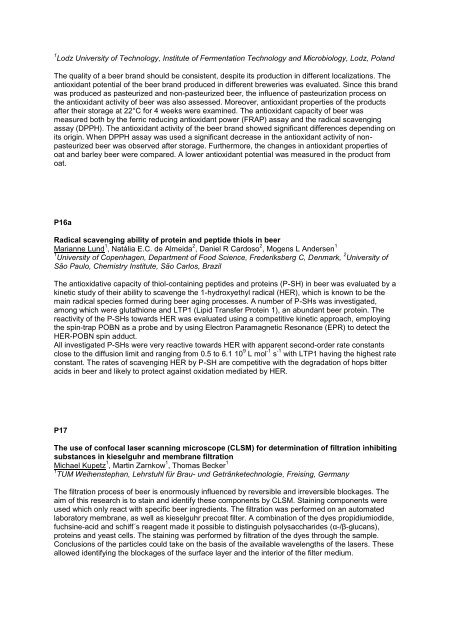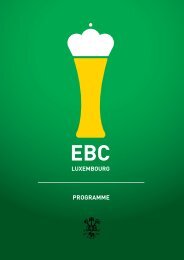here - the 34th European Brewery Convention
here - the 34th European Brewery Convention
here - the 34th European Brewery Convention
You also want an ePaper? Increase the reach of your titles
YUMPU automatically turns print PDFs into web optimized ePapers that Google loves.
1 Lodz University of Technology, Institute of Fermentation Technology and Microbiology, Lodz, Poland<br />
The quality of a beer brand should be consistent, despite its production in different localizations. The<br />
antioxidant potential of <strong>the</strong> beer brand produced in different breweries was evaluated. Since this brand<br />
was produced as pasteurized and non-pasteurized beer, <strong>the</strong> influence of pasteurization process on<br />
<strong>the</strong> antioxidant activity of beer was also assessed. Moreover, antioxidant properties of <strong>the</strong> products<br />
after <strong>the</strong>ir storage at 22°C for 4 weeks were examined. The antioxidant capacity of beer was<br />
measured both by <strong>the</strong> ferric reducing antioxidant power (FRAP) assay and <strong>the</strong> radical scavenging<br />
assay (DPPH). The antioxidant activity of <strong>the</strong> beer brand showed significant differences depending on<br />
its origin. When DPPH assay was used a significant decrease in <strong>the</strong> antioxidant activity of nonpasteurized<br />
beer was observed after storage. Fur<strong>the</strong>rmore, <strong>the</strong> changes in antioxidant properties of<br />
oat and barley beer were compared. A lower antioxidant potential was measured in <strong>the</strong> product from<br />
oat.<br />
P16a<br />
Radical scavenging ability of protein and peptide thiols in beer<br />
Marianne Lund 1 , Natália E.C. de Almeida 2 , Daniel R Cardoso 2 , Mogens L Andersen 1<br />
1 University of Copenhagen, Department of Food Science, Frederiksberg C, Denmark, 2 University of<br />
São Paulo, Chemistry Institute, São Carlos, Brazil<br />
The antioxidative capacity of thiol-containing peptides and proteins (P-SH) in beer was evaluated by a<br />
kinetic study of <strong>the</strong>ir ability to scavenge <strong>the</strong> 1-hydroxyethyl radical (HER), which is known to be <strong>the</strong><br />
main radical species formed during beer aging processes. A number of P-SHs was investigated,<br />
among which were glutathione and LTP1 (Lipid Transfer Protein 1), an abundant beer protein. The<br />
reactivity of <strong>the</strong> P-SHs towards HER was evaluated using a competitive kinetic approach, employing<br />
<strong>the</strong> spin-trap POBN as a probe and by using Electron Paramagnetic Resonance (EPR) to detect <strong>the</strong><br />
HER-POBN spin adduct.<br />
All investigated P-SHs were very reactive towards HER with apparent second-order rate constants<br />
close to <strong>the</strong> diffusion limit and ranging from 0.5 to 6.1 10 9 L mol -1 s -1 with LTP1 having <strong>the</strong> highest rate<br />
constant. The rates of scavenging HER by P-SH are competitive with <strong>the</strong> degradation of hops bitter<br />
acids in beer and likely to protect against oxidation mediated by HER.<br />
P17<br />
The use of confocal laser scanning microscope (CLSM) for determination of filtration inhibiting<br />
substances in kieselguhr and membrane filtration<br />
Michael Kupetz 1 , Martin Zarnkow 1 , Thomas Becker 1<br />
1 TUM Weihenstephan, Lehrstuhl für Brau- und Getränketechnologie, Freising, Germany<br />
The filtration process of beer is enormously influenced by reversible and irreversible blockages. The<br />
aim of this research is to stain and identify <strong>the</strong>se components by CLSM. Staining components were<br />
used which only react with specific beer ingredients. The filtration was performed on an automated<br />
laboratory membrane, as well as kieselguhr precoat filter. A combination of <strong>the</strong> dyes propidiumiodide,<br />
fuchsine-acid and schiff´s reagent made it possible to distinguish polysaccharides (α-/β-glucans),<br />
proteins and yeast cells. The staining was performed by filtration of <strong>the</strong> dyes through <strong>the</strong> sample.<br />
Conclusions of <strong>the</strong> particles could take on <strong>the</strong> basis of <strong>the</strong> available wavelengths of <strong>the</strong> lasers. These<br />
allowed identifying <strong>the</strong> blockages of <strong>the</strong> surface layer and <strong>the</strong> interior of <strong>the</strong> filter medium.





